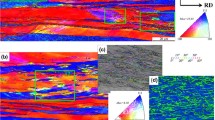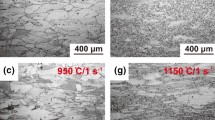The method of orientation microscopy (EBSD) is used to study the special features of recrystallization texture in drawn copper wire. It is shown that the strict crystallographic relationships between deformation and recrystallization orientations are consequences of the dominant role in structural transformations of special misorientations, i.e. special boundaries. Mechanisms of the appearance and “growth” of annealing twins are proposed.



Similar content being viewed by others
References
Yu. N. Loginov and V. V. Kotov, “Texture development in copper semiproducts,” in: Features of Treatment and Use of Heavy Nonferrous Metal Objects [in Russian], UrO RAN, Ekaterinburg (2006).
A. S. Belyaevskikh, M. L. Lobanov, G. M. Rusakov, and A. A. Redikul’tsev, “Improving the production of superthin anisotropic electrical steel,” Steel Transl., 45(12), 982 – 986 (2015).
I. Yu. Pyshmintsev, A. O. Struin, A. M. Gervasyev, et al., “Effect of bainite crystallographic texture on failure of pipe steel sheets made by controlled thermomechanical treatment,” Metallurgist, 1 – 8 (2016).
G. Gottstein, Physical Foundation of Materials Science, Springer-Verlag, Berlin Heidelberg (2004).
Ya. D. Vusnyakov, A. A. Babareko, S. A. Vladimirov, and I. V. Égiz, Theory of Texture Formation in Metals and Alloys [in Russian], Nauka, Moscow (1979).
S. L. Demakov, Y. N. Loginov, A. G. Illarionov, et al., “Effect of annealing temperature on the texture of copper wire,” Phys. Met. Metallogr., 113(7), 681 – 686 (2012).
A. Rollett, F. Humphreys, G. S. Rohrer, and M. Hatherly, Recrystallization and Related Annealing Phenomena: Second Edition, Elsevier Ltd (2004).
M. Hölscher, D. Raabe, and K. Lücke, “Relationship between rolling textures and shear textures in f.c.c. and b.c.c. metals,” Acta Metall. Mater., 42(3), 879 – 886 (1994).
A. G. Uritskii, A. A. Redikul’tsev, S. V. Smirnov, et al. “Structure and texture formation over the width of ferritic-steel strip in hot rolling,” Steel Transl., 44(10), 723 – 725 (2015).
M. L. Lobanov, S. V. Danilov, V. I. Pastukhov, et al., “The crystallographic relationship of molybdenum textures after hot rolling and recrystallization,” Mater. Des., 109, 251 – 255 (2016).
G. Wassermann and J. Grewen, Texturen Metallischer Werkstoffe, Springer, Berlin (1962).
T. Maitland and S. Sitzman, Electron Backscatter Diffraction (EBSD) Technique and Materials Characterization Examples, Springer, Berlin (2007).
M. L. Lobanov, A. A. Redikul’tsev, G. M. Rusakov, and S. V. Danilov, “Interrelation between the orientations of deformation and recrystallization in hot rolling of anisotropic electrical steel,” Met. Sci. Heat Treat., 57(7 – 8), 492 – 497 (2015).
A. A. Redikul’tsev, L. M. Lobanov, G. M. Rusakov, and L. V. Lobanova, “Secondary recrystallization in Fe – 3 % Si alloy with (110)[001] single-component texture,” Phys. Met. Metallogr., 114(1), 33 – 40 (2013).
P. Haasen, “How are new orientations generated during primary recrystallization?” Metall. Trans. A., 24(5), 1001 – 1015 (1993).
Y. V. Khlebnikova, D. P. Rodionov, I. V. Gervas’eva, et al., “Perfect cubic texture, structure, and mechanical properties of nonmagnetic copper-based alloy ribbon substrates,” Tech. Phys., 60(3), 389 – 399 (2015).
T. Baudin, A. L. Etter, and R. Penelle, “Annealing twin formation and recrystallization study of cold-drawn copper wires from EBSD measurements,” Mater. Charact., 58(10), 947 – 953 (2007).
F. Brisset, A.-L. Helbert, and T. Baudin, “In situ electron backscatter diffraction investigation of recrystallization in a copper wire,” Microsc. Microanal., 19(4), 969 – 977 (2013).
J.-H. Cho, A. D. Rollet, J.-S. Cho, et al., “Investigation of recrystallization and grain growth of copper and gold bonding wires,” Metall. Mater. Trans. A, 37(10), 3085 – 3097 (2006).
H. Park and D. N. Lee, “The evolution of annealing textures in 90 Pct drawn copper wire,” Metall. Mater. Trans. Phys. Metall. Mater. Sci., 34A(3), 531 – 541 (2003).
K. R. Narayanan, I. Sridhar, and S. Subbiah, “Experimental and numerical investigations of the texture evolution in copper wire drawing,” Appl. Phys. Mater. Sci. Proc., 107(2), 485 – 495 (2012).
K. Rajan and R. Petkie, “Microtexture and anisotropy in wire drawn copper,” Mater. Sci. Eng. A, 257, 197 (1998).
T. Montesin and J. J. Heizmann, “Evolution of crystallographic texture in thin wires,” J. Appl. Crystallogr., 25(6), 665 – 673 (1992).
D. N. Lee, “Strain energy release maximization model for recrystallization textures,” Met. Mater. Int., 5(5), 401 – 417 (1999).
S. I. Wright, J. F. Bingert, and L. Zernow, “Microtextural zones in a copper shaped charge particle,” Mater. Sci. Eng. A, 207(2), 224 – 227 (1996).
R. Penelle and T. Baudin, “Primary recrystallization of invar, Fe – 36% Ni alloy: Origin and development of the cubic texture,” Adv. Eng. Mater., 12(10), 1047 – 1052 (2010).
V. Randle, “Twinning-related grain boundary engineering,” Acta Mater., 52, 4067 – 4081 (2004).
D. P. Field, L. T. Bradford, M. M. Nowell, and T. M. Lillo, “The role of annealing twins during recrystallization of Cu,” Acta Mater., 55(12), 4233 – 4241 (2007).
N. Souaï, N. Bozzolo, L. Nazé, et al., “About the possibility of grain boundary engineering via hot-working in a nickel-base superalloy,” Scr. Mater., 62(11), 851 – 854 (2010).
J. G. Brons and G. B. Thompson, “A comparison of grain boundary evolution during grain growth in fcc metals,” Acta Mater., 61(11), 3936 – 3944 (2013).
O. A. Kaibyshev and R. Z. Valiev, Grain Boundaries and Metal Properties [in Russian], Metallurgiya, Moscow (1987).
The authors are grateful for cooperation of the support program of leading RF universities with the aim of increasing their competitiveness No. 211 of the RF government No. 02.A03,21.0006. Work performed within the scope of a RFFI grant (No. 16-32-00030mol a), also an RF President grant No. MK-1032.2017.8, and also within the scope of a state assignment FANO Rossii, theme “Structure” registration number 01201463331.
Author information
Authors and Affiliations
Corresponding author
Additional information
Translated from Metallovedenie i Termicheskaya Obrabotka Metallov, No. 5, pp. 55 – 61, May, 2018.
Rights and permissions
About this article
Cite this article
Zorina, M.A., Lobanov, M.L., Makarova, E.A. et al. Primary Recrystallization Texture in FCC-Metal with Low Packing Defect Energy. Met Sci Heat Treat 60, 329–336 (2018). https://doi.org/10.1007/s11041-018-0280-8
Published:
Issue Date:
DOI: https://doi.org/10.1007/s11041-018-0280-8




